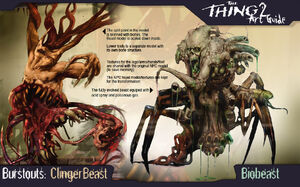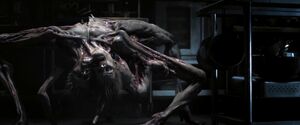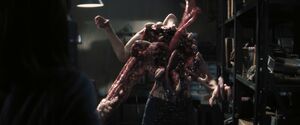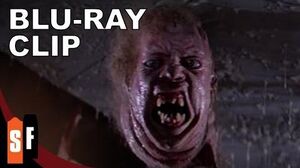No edit summary |
(→Trivia) |
||
| Line 148: | Line 148: | ||
*There is a fan theory that at the conclusion of the 1982 film, that Childs is actually the Thing. This is backed up by Childs' different attire, and lack of visible breath. The theory also suggests that MacReady filled the scotch bottle with gasoline to test this possibility, and that the Thing inadvertently gave himself away by drinking it (hence MacReady's demoralized laugh.). |
*There is a fan theory that at the conclusion of the 1982 film, that Childs is actually the Thing. This is backed up by Childs' different attire, and lack of visible breath. The theory also suggests that MacReady filled the scotch bottle with gasoline to test this possibility, and that the Thing inadvertently gave himself away by drinking it (hence MacReady's demoralized laugh.). |
||
*Jon Carpneter has stated that his interpretation of the creature was inspired by the [[Shoggoth]]. |
*Jon Carpneter has stated that his interpretation of the creature was inspired by the [[Shoggoth]]. |
||
| + | *The Thing was featured along with other horror icons in the Halloween sale promotion for Vivziepop's ''Hasbin Hotel.'' |
||
[[Category:Monsters]] |
[[Category:Monsters]] |
||
[[Category:Parasite]] |
[[Category:Parasite]] |
||
Revision as of 22:55, 15 October 2019
| This article's content is marked as Mature The page contains mature content that may include coarse language, sexual references, and/or graphic violent images which may be disturbing to some. Mature pages are recommended for those who are 18 years of age and older. If you are 18 years or older or are comfortable with graphic material, you are free to view this page. Otherwise, you should close this page and view another page. |
| “ | This thing doesn't want to show itself; it wants to hide inside an imitation. It'll fight if it has to, but it's vulnerable out in the open. If it takes us over, then it has no more enemies. Nobody left to kill it. And then it's won. | „ |
| ~ R.J. MacReady explaining The Thing's vicious prowess in The Thing (1982 film). |
| “ | It attacks its prey, copies it perfectly and then hides inside it. | „ |
| ~ Kate Lloyd explaining The Thing's life cycle in The Thing (2011 film). |
The Thing is the titular main antagonist and the alias given to the hostile alien creature featured in the 1938 short story "Who Goes There?" by the late John W. Campbell, that (compared to the deviated story of the 1951 film The Thing from Another World) was made into a 1982 live action film by John Carpenter following a prequel to it released in 2011.
Initially appearing as a single being, every cells in The Thing's body are autonomous and independent, capable of creating more of said monsters through assimilation, parasitism and infection. In addition, every spawned monsters look radically different and none of them have definite shape that can be called "true form". Ultimately, the Thing's true body and form is a mystery as it most appears as who ever it impersonates.
In the 1951 film, it was played by the late James Arness. In the 1982 film, it was played by the late wolfdog actor Jed and its vocal sound effects were provided by Alan Howarth.
Description and Traits
In nature, the Thing is basically an ambush predator, isolating a potential victim or threat to consume and assume its form. In certain cases, usually when exposed or the person it assimilated is fatally inflicted, the Thing will discard all caution and defend itself by manifesting features that may be of its natural form, including tendrils, claws, and mouths. However, the Thing's most dangerous aspect is its cells, each a functional life form that can become independent from the main body when severed by force or separate to assimilate and self-preservation. For this reason, it is necessary to destroy the body down to the cellular level with incineration an effective method.
Behavior and Intelligence
The Thing has only assimilation and self-preservation in mind, as it will selfishly save itself or even attack other forms of its manifestation/progeny in order to avert attention and suspicion. When The Thing is left alone with a suitable target, it will begin to split open and fire out tendrils, which grab the target and begin to assimilate it. In certain cases after discovery or high chance of discovery, The Thing will sometimes perform "divide and conquer" tactics, as in the case of the assimilated Edward which split up into three separate forms: One on his hand quickly detaches and animated itself before engaged and began assimilating Jonas, another limb scuttled away soon after detaching for potential assimilation in a safer location, and the main body of the Edvard thing killed Derek and successfully assimilated Adam Finch, resulting a form of The Thing named Split-Face. This is also performed, albeit much less successfully, by the Norris-Thing. When exposed, Things will react depending on how big they are compared to the threat. Smaller Things will generally attempt to escape and ambush prey when the individual is more vulnerable. However, a larger Thing will usually attack prey head on and attempt to overwhelm any hostiles instead of escaping, although if it has not completely lost its cover it will attempt to flee.
In terms of intelligence, The Thing's intelligence depends on the size of their manifestations: Smaller ones are quite stupid, dimwitted, nonsensical and reckless while the larger ones, especially those who imitate a human are quite cunning, manipulative and formidably calculating. For example, Norris' mutated head foolishly led itself seen by MacReady and his friends while scuttering away from them that resulting its incineration. Because The Thing can acquire the memories and knowledge of those who it previously assimilated, they can used the said memories and knowledge for their advantage, though only larger manifestations of The Thing that more competent to do so: Thing Beast who has assimilated Sander was capable of taking control over UFO which brought it to Earth while the assimilated Blair on the other hand, build a makeshift UFO and aware how dynamite works as when ambushing MacReady, it disposed the detonator before revealing itself to confront him. However, this not always apply to all larger manifestation of Thing Beasts: Rapture-type Thing Beasts (see below) have no intention of hiding themselves from view as well as not manifesting useful appendages that supposedly give them advantage in battle like legs, and their chosen forms act primarily with little intelligence. A plausible explanation of this is likely Rapture-type Thing Beasts' own overconfidence against their foes that they believe mobility to evade their foes' attacks unnecessary due to their formidable but stationary form.
When exposed, The Thing would attack anyone on sight to save itself. This somewhat serves as their psychological weakness due to their aggressive mood blinded them from serious threat that their foes unexpectedly posed on them: The Thing who manifested from assimilated Juliette recklessly attempted to kill Kate and the others as soon as it unveil its true form which ironically led to its incineration. Should it survived the ordeal from its foes/preys and managed to hide, The Thing would regain its composures in order to use their original intelligence once again: When Split-Face Thing confronting Sam, it hesistate upon noticing his flamethrower.
The Thing's ability to interact with plant based life-forms is largely unknown. Its only interaction with plant based life was in the form of wood/clothing fibers. It cannot absorb these as noted by MacReady, which could suggest an inability to absorb plant cells or dead cells. The Thing themselves also a remarkable Master Manipulator in certain degree, not only because they enciting paranoia among their foes and victims alike, but also not shown eating or drinking beyond living humans or dogs, and it also leaves the bodies of killed humans or dogs untouched even though there is usable biomass, implies that it understands that potential hosts will react strangely to the presence of someone they know to be deceased. Possible other reasons why it never seen assimilating fresh corpses was either it only able to assimilate victim alive or aware that missing dead bodies would arouse suspicion.
In another feat of reasoning, a Thing destroyed a test that would have lead to its exposure, demonstrating awareness of biology and medical practices that would have exposed it. Interestingly, the second time this same method was proposed as a test the Thing had seemingly preempted the idea, this despite the fact that the Thing that had arrived at the second base was spawned long before the first test was thought of and was in a non-human form. This lead to the theory of a shared consciousness between Things, especially as the second sabotage was far harder to pull off covertly and while sowing seeds of misdirection it also exposed its presence.
Biography
The Thing (1982) & The Thing (2011)
| “ | Stay away from that thing! That is not a normal dog but a monster! It is not real, it is a replicate you damn fools! | „ |
| ~ Lars frantically warning in Norweigian to MacReady's crew before his death. |
The depiction of The Thing from these two modern movies are a lot more faithful to the original novella description than the 1951 counterpart.
Its origin a mystery, the Thing crash landed in a spacecraft within the icy fields of Antarctica 100,000 years ago and was frozen attempting to escape. However, in 1982, the spacecraft and the Thing were found by a team of American and Norwegian explorers/researchers under Dr. Sander Halvorson from Thules station, who hired Columbia University paleontologist Kate Lloyd to take a sample of the creature's blood as it was brought to the base in a block of ice. But later that evening, the Thing bursts from the ice and kills Lars' Alaskan Malamute, Jed while ingesting Henrik before it was burned alive. However, an autopsy of the scorched alien corpse reveals that its cells are still alive and in the process of assimilating Henrik.
When Kate realizes the Thing already might have had assimilated others, she places the base on quarantine to weed out the Thing based on those who still have metal fillings in their teeth and such, after her initial plan of weeding out the monster through blood sample test had been sabotaged by The Thing. Due to The Thing's ability of imitate, emulate, mimic and appearing exactly like any of research members paranoid began to set in. Eventually the majority of research team were infected and incinerated before Sander, having been infected, makes a run for the spaceship. Kate and Sam Carter, the only two surviving crew members, chase Sanders to the alien UFO where Kate and Carter got separated. Kate eventually manages to pursue and kill the monster and heavily damages the ship to be beyond any repair. After reuniting with Carter, Kate resolved herself to catch him off guard and incinerated him when he is discovered that his earring he previously wore was missing and pointed to the wrong ear when confronted. When Carter was set aflame he emitted an inhuman scream, another evidence that Carter was The Thing. After this Kate is left all alone, leaving her fate unknown.
Meanwhile back at the Thules station, Lars' dog (having been infected and lying low until the time was right) makes its way to an American Antarctic research station with Lars attempting to kill it before he was shot by Lt. Garry, the station commander. Helicopter pilot R.J. MacReady and Dr. Copper fly to the Norwegian's camp, finding the charred remains of the various Things included the burnt yet preserved corpse that was the station's commander Edvard Wolner after it assimilated Sander's assistant Adam Finch.
After the two-faced corpse was brought to the base, the Americans realize the Thing's presence too late when Lar's dog was placed in a kennel with the station's sled dogs and attempted to assimilate them all. After Childs incinerates the creature, with the team finding the ruins of the spacecraft, the autopsy done by Blair confirms the Thing's nature as he later proceeds to trap everyone on the base and kill the remaining dogs so no one can leave until the Thing is truly dead before being locked in a tool shed by the others as they devised a way to weed out the Thing by using its autonomous cells to weed out the assimilated. By the time that McReady and the other normal humans remain, they learn that Blair got assimilated and is building a small escape craft. Realizing that the Thing may also intentionally freeze itself to wait for a rescue team in the spring, MacReady resolves to kill it with dynamite around the complex. After the Thing that Blair became is dead, with Garry and Nauls killed off prior, MacReady finds Childs with both thinking the other got assimilated before seeing no point in distrusting each other as they would die of frost within hours.
In Videogames
In the 2002 videogame "The Thing", which serves as sequel for the 1982 film and set 3 months after events of the said film, it is revealed that The Thing still alive and waiting for more victims to absorb and kill. This time, there are more numerous manifestation of this alien lifeform at once and worse, everything became more complicated as most of them have been captured as means to be repurposed into bioweapons by Gen Inc. Things went wrong however, following their escape, Whitley, the mastermind behind the experiment to modify The Thing into bioweapons, has inject himself with Cloud virus, viral agent based on Thing's cells and planned to infect the whole planet. Fortunately, Blake (the protagonist of the game) foiled his plan and destroyed him with help of MacReady, sole survivor of the 1982 film, before he had a chance to infect the rescue team.
In the videogame, The Thing was regarded more like viral organism that has the ability to replicate the original biological entity, including their clothing. This likely due to in the said game, The Thing had further developed its ability which intrigued Gen Inc. to experimenting on it.
Variants In-Game
Scuttlers
A form of Thing that has assimilated and formed from mutilated body parts (often from those whom already assimilated by Thing's cells). These autonomous small Things' primary transformation involves manifesting teeth, arachnid-like limbs, and also a pair of strong hind legs that enable them to leap toward the non-assimilated lifeforms. Aside leaping, they could either attacking by biting or spitting digestive fluid as projectile. They could be crippled easily by crippled it first with few shots from guns before finished by a single blast from flamethrower. They were inspired by mutated form of Norris' head after mutated by Thing's cells.
Scuttler Pods
A form of Thing that in form of fleshy, blob-like biomass that immobile but dangerous due to manifesting Scuttlers as means of defense. Their prime weakness is incapable of moving nor having alternate means of defense and can be destroyed by a blast of flamethrower and variety of firearms.
Walkers
Form of Thing that manifest as humanoid monster with deformed torso, deformed claw hands, and insectoid legs that formerly humanoid ones. Their early form were brutish, muscular monster with a huge, transparent hole in their torso.
Imitations
Imitations are form of Thing that previosuly introduced in the films. They perfectly assumed their victim's appearance and able to transformed to their mutated form when their potential victims lower their guard. For the game incarnations, they tend to retain some elements of their hosts' appearance like clothes that still intact though their limbs in mutated state, similar with the mutated Palmer in the 1982 film.
Dog Beasts
Thing beast that similar with mutated form of Lar's dog as both formerly has assimilated dogs. But unlike the latter, Dog Beasts still retain their limbs (though the said bodyparts also mutated to the point where they could support their weight as well as enable them to run at the tremendous speed).
Ruptures
They are form of huge Things that take up an entire room or even be part of the room integrated into the architecture. Typically, they have human forms imbedded in them and attack with tentacles, teeth and fluids. They are immobile and are confined to the location in which they are met, which made them vulnerable due to unable to avoid their enemies' attacks.
Weakness and Countermeasures
Though their deadly capacities in assimilation and other abilities made The Thing became a villainous, threatening force to deal with, there's a number of methods that can be done to expose them:
- The Thing cannot assimilated non-organic components (for example, tooth fillings or prosthetics) on the victims. So, when one notice one of their friends not wearing any earrings/tooth fillings/prosthetics/other non-organic components that embedded/put on their body, they likely have been previously assimilated into a manifestation of The Thing. This method is the least effective in exposing a Thing's manifestation.
- Blood Tests: There are three type of blood test that can be done to differentiate regular lifeforms and the assimilated ones which actually a Thing in disguise:
- Blood serum test: A suspected imitation's blood is mixed with uncontaminated blood; which will hypothetically react if the creature is an impostor. This was yet to be proven effective, as The Thing quickly destroyed stored sacks of uncontaminated blood to avoid suspicion.
- Hot needle test: When a sample of disguised Thing's blood is burned with a hot needle, the blood would jumped away from the needle. If the blood sample was taken from yet to be assimilated person, the blood would simply burnt.
- Blood Test Hypo tool: More advanced version of the previous method, where this device extracted a suspected person's blood and it mixed the said blood with stored chemical agent. As before, the blood would animates and make an attempt to escapes, but failed as chemical agent killed it.
Aside the means of exposing a disguised Thing, the methods to killing them are:
- Electrocution: Electrocution works against The Thing as the method would fry it's cells as seen in Who's Got There?, as well as implied by a Thing's manifestation from Norris' body which suddenly reacts by chomping on Chopper's hands when the latter tries to electrocute him.
- Explosives: Explosive can obliterate Thing completely into pieces, effective to weakened the larger Thing beasts before incinerate their remains.
- Incineration: Incineration can killed a Thing manifestation as fire would destroyed it in cellular level, but this mostly effective on medium to smaller sized Thing manifestation, as the larger one had a chance to survive albeit incapacitated, as proved when Split-Face Thing whom part of it survived in spite of being heavily injured by Kate's flamethrower.
The last two known weakness that The Thing possessed are:
- As previously mentioned before, upon being exposed, a Thing manifestation would angrily attack and assimilate anyone on sight which give their foes an opening.
- The Thing had a limit in maximum size expansion during assimilation process, as had they grown too large during the assimilation process, this would transformed them into a boiling mass of flesh and random body parts where in this state, hindered their mobility and made them vulnerable.
Gallery
Images
Videos
Trivia
- It is a basis for The Abnormal from the Doug episode "Nightmare on Jumbo Street".
- There is a fan theory that at the conclusion of the 1982 film, that Childs is actually the Thing. This is backed up by Childs' different attire, and lack of visible breath. The theory also suggests that MacReady filled the scotch bottle with gasoline to test this possibility, and that the Thing inadvertently gave himself away by drinking it (hence MacReady's demoralized laugh.).
- Jon Carpneter has stated that his interpretation of the creature was inspired by the Shoggoth.
- The Thing was featured along with other horror icons in the Halloween sale promotion for Vivziepop's Hasbin Hotel.

























